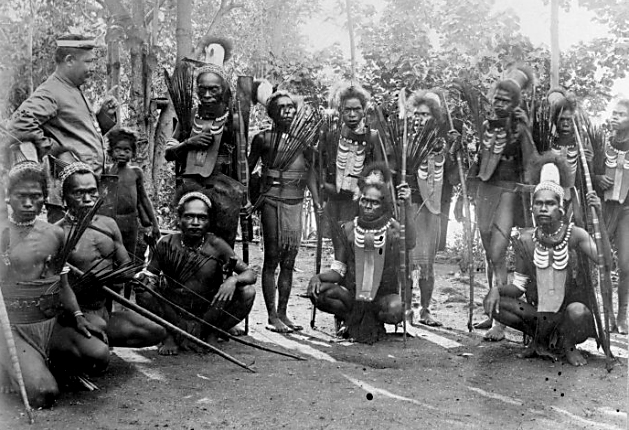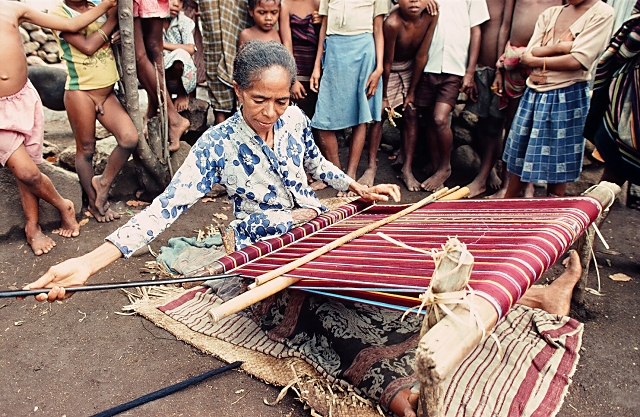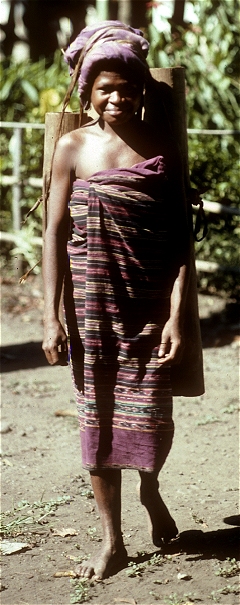Remote, fascinating Alor
More than a dozen indigenous languages are spoken on the island, most of them Papuan or non-Austronesian - and most of them dying out, to be replaced by Bahasa Indonesia, the new lingua franca, and Alurung. Most Alorese have been converted to Christianity, but in coastal villages such as Alor Besar and Alor Kecil Islam predominates and people speak Alurung, which is also the language of the islets Buaya and Ternate. Animist beliefs and practices survive under the monotheist veneer, though not to the extent that they do in most other parts of Indonesia. Our own observation when we visited Alor in 1981 was that people seemed to live in a spiritual void. All their old beliefs had been taken from them, they had in fact been made fearful about them, and they had been given nothing else they could truly embrace. To use Rodemeier's phrase: ...people "became ‘silent’ in the course of time", which we experienced as quite saddening, especially if one knows what a proud warlike people the Alorese used to be. Relatively little is known about ikat production on Alor. Even a comprehensive handbook like Robyn Maxwell's Textiles of Southeast Asia has only a passing reference to the island, and in 1991 Brigitte Khan-Majlis stated in her Woven Messages: "Textiles from the neighbouring islands of Pantar and Alor were virtually unknown until now." Little has changed since then. Most authors rely on the observations made by the German anthropologist Ernst Vatter who visited Alor and surrounding islands in 1928/29 with his wife Hanna, and published his findings in the famous Ata Kiwan. Vatter found but little ikat weaving on the island, limited to Alor Kecil on the northwestern peninsula - and no weaving at all in the mountainous, practically inaccessible interior. In 2012 the author of Wereldmuseum's impressive Magie van de Vrouw confirmed the rarity of Alor textiles and the paucity of information: 'Not much is known about the textiles of Alor, few of which are found in Western collections.' Lamaholot style, with eclectic touchesAs for the Alorese style, it conforms largely to the general Lamaholot pattern of horizontal bands, mostly narrow, some mere stripes, decorated with small geometric motifs, and a preference for morinda red. Western Alor and its small off-shore islands have a history of using stylized aquatic animals. There is much evidence of inter-regional influence. So much in fact that it is not even clear whether all cloths in western collections that are tagged with Alor provenance have actually been made there. Some may instead have been woven on neighbouring Pantar or Lembata (e.g. in the village of Ili Api), or on Adonara; others may have been made on Alor, but by people from other islands. To illustrate the point: we saw (see photo below) a woman weaving an ikat sarong in a hamlet near Alor Kecil, on the northwestern peninsula. But if we look closely we notice that the weaver wears a sarong with Sikka design, i.e. 'from Flores'. Did she come over from Flores to do some weaving jobs in local style for a people who had forgotten their old skills? Of course we should have noticed and asked at the time, but due to the general excitement about our arrival in the extremely backward village it was such a madhouse that we were happy enough just to get a few shots.Esthetically pleasing simplicityEven though ikat from Alor generally does not stand out by creativity or technical finesse, the cloths from this island are keenly sought, and old sarongs of good quality command high prices on the international market. One reason for this no doubt is that they are not often encountered, but rarity alone is not sufficient to generate high demand. Another reason may be esthetic. Their simplicity of design and the muted, earthy colours, give Alor ikat an austere, almost introvert, appearance that appeals to refined tastes. As Vatter wrote: "The ornamentation of these textiles is also simple, but their simplicity is here an esthetic advantage." When he directly compared the cloths of the Lamaholot region which includes Alor with the more immediately appealing textiles from Sumba, or even Savu and Roti, he noted that "in the long term these have a more lasting artistic effect." But perhaps the most important reason for the high value of Alor ikat is the sustained fascination for all things Alor that Vatter generated with his book - which is likewise rare, and expensive. A group of Alorese warriors photographed around 1900, some 30 years before the arrival of Ernst Vatter. Photographer unknown, early 20th C. Tropenmuseum of the Royal Tropical Institute (KIT), Creative Commons Licence. The elusive Alor sarong adatVatter described an island that had probably little changed in hundreds of years, inhabited by people of racially very diverse stock, including Papuan and Pygmee-like types, who spoke eleven different languages and manifested several unique customs and practices, such as a quinary numeral system (using five as the base), the typical Lamaholot use of elephants tusks, gading, and uniquely Alorese use of moko drums from the Dongsong culture as bridewealth. They were also warrior-like, originally very much so, and had a rich material culture, which the Vatters found relatively unadorned, but documented in great detail. It is hard to read their book and not get fascinated.We also got fascinated as we explored the island, though also very frustrated, as, unlike the Vatters, we did not manage to acquire even a single Alor ikat worth having, i.e. one woven according to the old rules of adat. The only ones offered were made with synthetic dyes, and looked both harsh and clumsy. We could perhaps have bought a few sarongs made with natural dyes straight off women's backs as we once did on Flores, but on the markets we visited most women wore cheap cottons from the Chinese stores on the coast, and the few older ikat sarongs that we did see were so simple and poorly adorned that they did not trigger the passion to collect. No doubt other collectors have left the island with the same disappointment, to pursue their quest for a high class Alor ikat on the international market. These days there is an active cottage industry on the island of Ternate, just off Alor's west coast, where 'adat' sarongs and other cloths are made for the upcoming Alorese tourist industry, usually in a mixture of natural and chemical dyes, in a visual style inspired by Lembata with the addition of cute motifs such as recognizable fishes, whales and turtles that sell well. To quote Susanne Rodemeier, whose research on Pantar led her to widen her scope to Alor: "In most regions of Alor people prefer to buy or barter cloth in stead of weaving it themselves. A cotton sarong from Alor Kecil for instance on Pura will be exchanged for two goats. As a consequence of the high value a sarong will only be used in a ritual context, as festive attire or as a shroud - and in exceptional cases as a blanket. Weaving is practiced only in Kolana, Halerman (Vatter 1932:281), and on Ternate, one of the islands in the Pantar Strait. But in these regions as well men and women only very rarely wear textiles of own manufacture. The majority of the population wears clothing made of cotton or man-made fibres imported by traders from Sulawesi. [..] Some years ago the production of [ikat, tH] clothing was taken to hand again in Kopidil (Kabola Peninsula, Alor). But here as well the clothing is not normally worn, serving only for 'dressing up in traditional garb' when passengers from tourists boats that drop anchor once or twice a year, get a show of local culture." Sadly, according to our own observation all of this was true already in the early 1980s. The vital role of watola (patola)As nearly everywhere in Nusantara, patola, locally called watola, are highly valued on Alor, and in a certain sense they are vital, perhaps more than anywhere else. Barnes, in her book on the Vatter collection, tells of the custom in the Batulolong region and in Kolana to cover a deceased raja's body with a meter long piece of a patola before piling on any other cloths that visitors would bring to join him in the grave. When Raja Welem Makunimau died in 1999, this custom was adhered to for the very last time, using the very last fragment in the clan's possession. The entire stock of patola had been used up over the generations. From the moment that there was no patolu left with which to sustain the tradition, the dynasty of the Tarawang clans came to an end. This is a sobering thought for all collectors (such as ourselves), curators and dealers who have been hunting patola in this region with such passion.Gomang in his study on the people of Alor and their alliances, shows a photo of an Alorese sarong with close imitation of a watola pattern. This type of cloth is very rare. According to one collector who acquired two late 19th C. examples on Alor in the early 1980s that were collectively owned by a village in Kolana, they were locally made. The striking similarity to sarongs made on Lembata makes one wonder though if this is not where they are from originally. 
Woman in a hamlet near Alor Kecil on the island of Alor weaving an ikat sarong (unfortunately made with chemical dyes) on traditional back strap loom in 1981. Curiously, she is weaving an Alor style cloth, but wearing a Sikka sarong from East Flores. Photo ©Peter ten Hoopen, 1981. |



